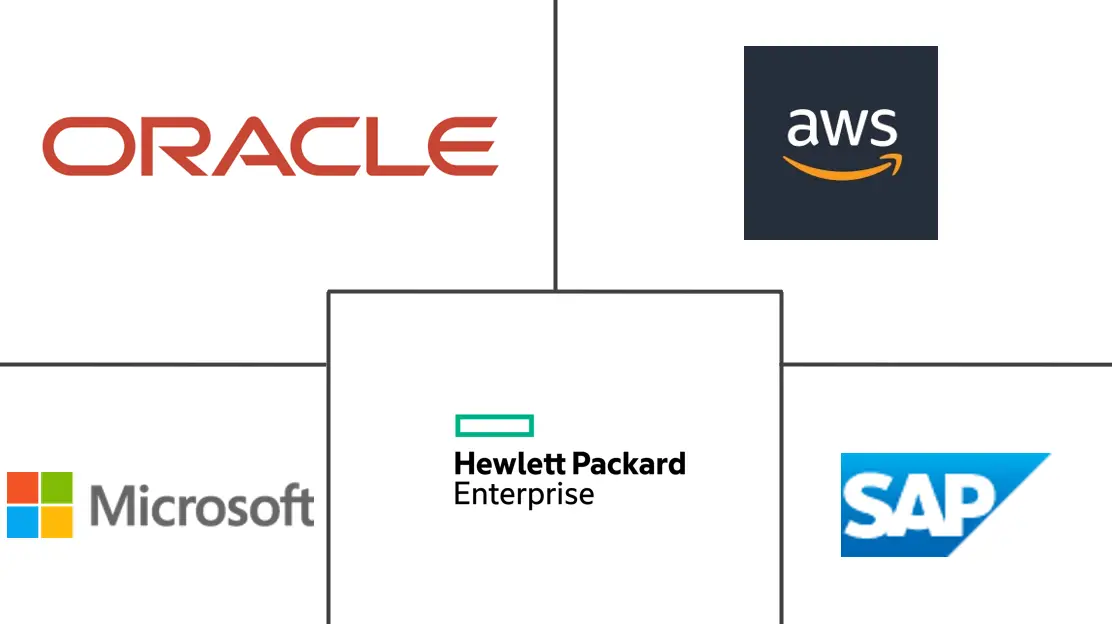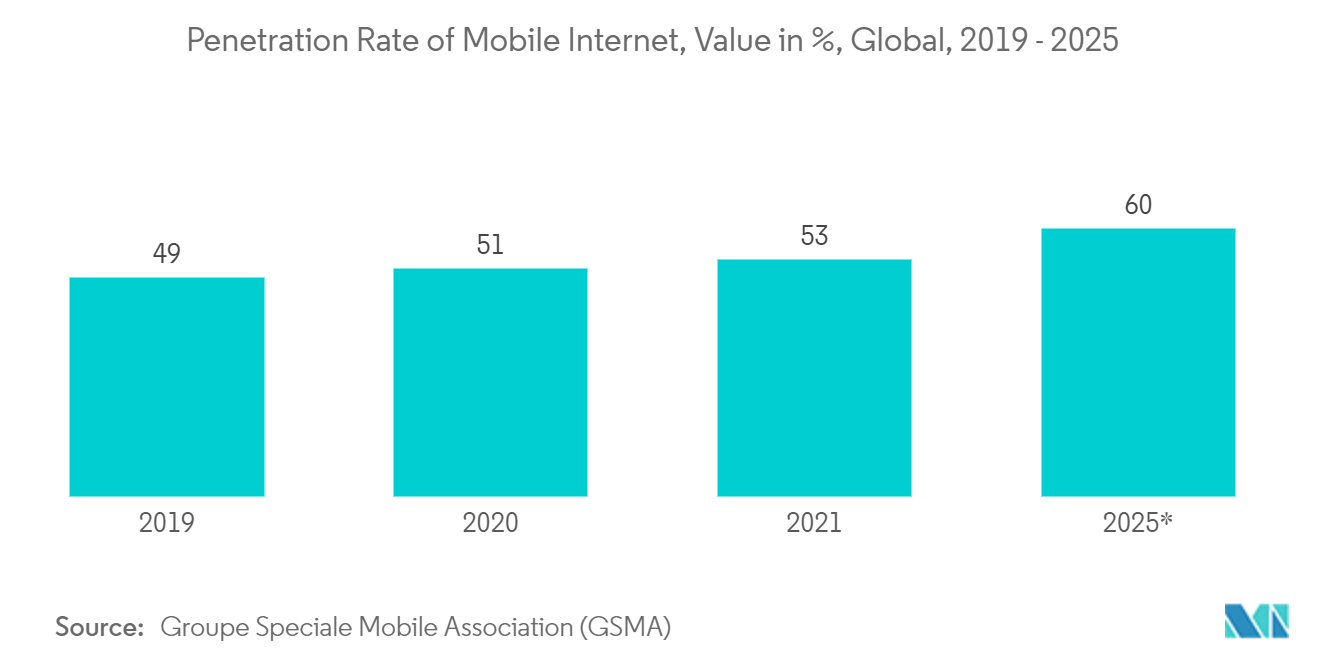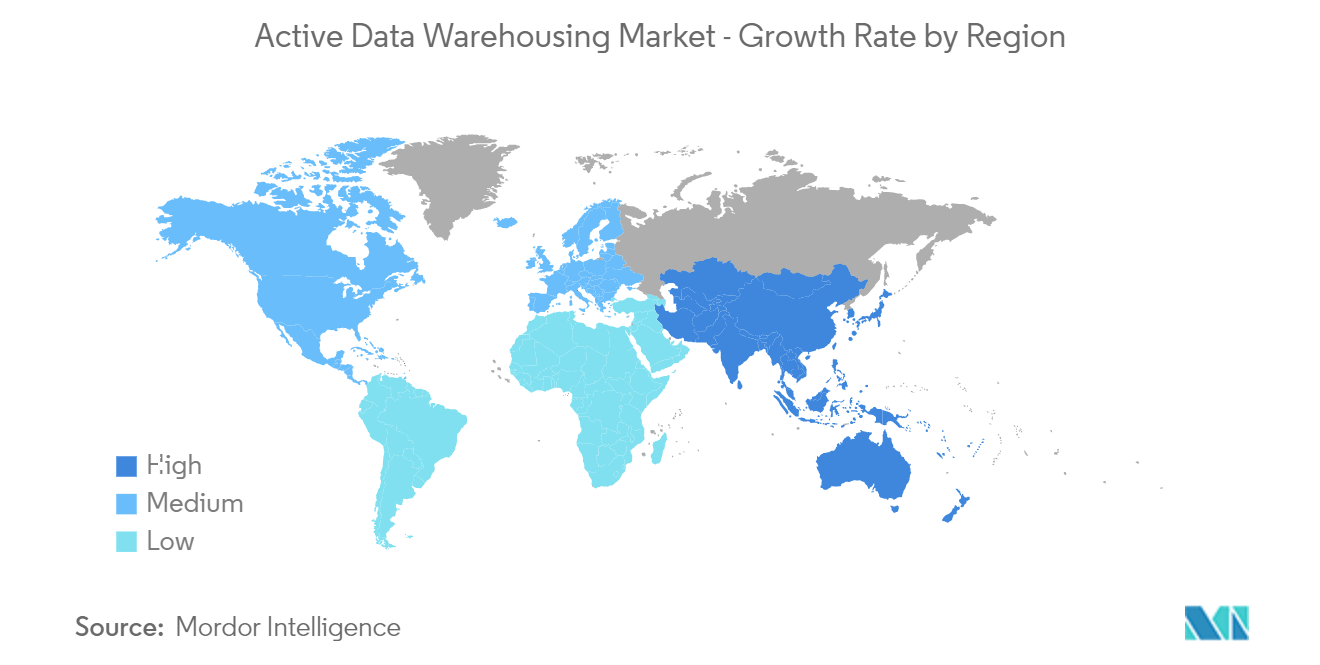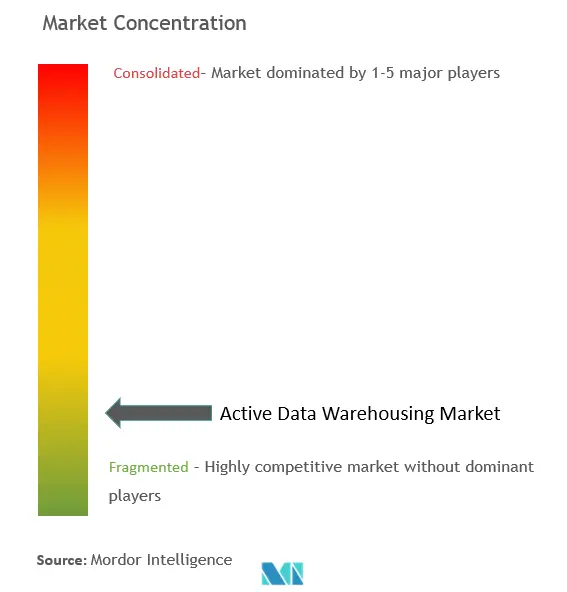
| Study Period | 2019 - 2029 |
| Market Size (2024) | USD 10.01 Billion |
| Market Size (2029) | USD 16.94 Billion |
| CAGR (2024 - 2029) | 11.10 % |
| Fastest Growing Market | Asia-Pacific |
| Largest Market | North America |
| Market Concentration | Low |
Major Players
*Disclaimer: Major Players sorted in no particular order |
Active Data Warehousing Market Analysis
The Active Data Warehousing Market size is estimated at USD 10.01 billion in 2024, and is expected to reach USD 16.94 billion by 2029, growing at a CAGR of 11.10% during the forecast period (2024-2029).
Additionally, the growth in demand from developing nations is anticipated to open up new opportunities for the active data warehousing market throughout the projection period.
- The active data warehousing market is poised for a significant shift, owing to factors like the ongoing demand for next-gen business intelligence coupled with the growing amount of data organizations generate. ADW allows users to access an enormous range of complex information in real-time. The data is organized efficiently and relevantly, which is anticipated to aid market growth over the forecast period. The rising demand for low latency and high-speed analytics, combined with the growing role of business intelligence in enterprise management, is expected to drive the market demand significantly.
- Further, according to Oracle, in Brazil, with nearly 90% of the population living in urban areas, SKY Brasil has approximately 29% market share for direct-to-home satellite services. The company opted for Oracle's Autonomous Data Warehouse running on Oracle Cloud Infrastructure, integrated into Oracle's Siebel CRM, to perform real-time, sophisticated marketing analytics. The deployer achieved 90% less time in deployment and commencing production than its previous on-premise solution while realizing 60% of infrastructure cost savings. Furthermore, ADW significantly diminishes the cost of computing, coupled with combining data in a single location, which is further projected to impact market growth positively.
- Additionally, ADW substantially decreases the cost of computing, coupled with combining data in a single location, which is also expected to impact the market growth positively. Along with these factors, globally, the significant rise in the Big Data trend in organizations is leading to the increasing demand for analytics, which is also projected to aid market growth. Also, to scale the computing capacity to match the demand and effortlessly scale back down when the usage peaks, vendors in the market have been following resource usage-based models for the pricing of cloud data warehousing. It addresses the issues of economies of scale that vendors may look for and the flexibility that clients demand. However, fixed-capacity data warehouses force organizations to buy more computing capacity than needed.
- Data warehousing has generated a lot of interest in real-world applications, notably in finance, business, healthcare, and other industries, as a result of growing concerns about data management and rising complexity. Digitalizing corporate processes led to the adoption of new technologically advanced operations with data analytics capabilities in the IT industry. As a result, modern data warehouse systems facilitate the development of the real-time, enterprise-scale analytics and information insights required for digital business operations.
- However, the market for active data warehousing is being restrained by various factors, including high installation costs and increased cyber threats.
- COVID-19 created a mixed impact on the market. For instance, in a survey of 300 analytics professionals in the US, Burtch Works and the International Institute for Analytics (IIA) revealed that over 43% of respondents said that analytics was a crucial factor in their actions to make essential choices in response to the COVID-19 problem. Companies scaled back operations due to the pandemic epidemic, reduced expenses, and closed offices. The widespread adoption of the work-from-home paradigm presents another difficulty for firms. Cloud-based data warehouse installations are anticipated to be accelerated by such developments. The pandemic provided numerous advantages for adopting data warehousing, including cost-effectiveness, access to a large skill pool, and enhanced scalability.
Active Data Warehousing Market Trends
Rising Penetration of Smartphones may Drive the Market Growth
- Mobile phones, especially smartphones, are becoming increasingly widespread among various people. Users may get essential information rapidly owing to modern information and communication technology (ICT). According to the GSMA, there are more than 6.2 billion active iOS and Android smartphones worldwide as of last year, and it is expected to reach 7.4 billion by 2025. Additionally, the usage of mobile technology is increasing across a range of computer systems, including Data Warehouse (DW), Business Intelligence (BI) systems, and Data Analytic systems.
- Mobile phones act as a database, where a considerable amount of user data is stored. The stored data can be subjected to analysis as per the T&C approval by the user. The data can be retrieved and analyzed by various active data warehouses to collect multiple traits of the user. Smartphone users need a vast cloud database for data access, thereby needing data warehousing solutions, driving market growth.
- Further, an increasing data stream necessitates more capabilities, including real-time data storage, as a result of the rising smartphone usage in emerging nations like China, Brazil, and India, as well as the increased social media traffic.
- Moreover, the growing smartphone usage across various countries is anticipated to drive market growth. For instance, according to the Ministry of Information and Broadcasting, in November 2022, India had more than 1.2 billion mobile phone subscribers, including 600 million smartphone users. Furthermore, it was mentioned that in addition to having relatively cheap data rates, the widespread usage of smartphones has led to individuals consuming a lot of information and entertainment on their mobile devices.

North America is Expected to Hold a Significant Market Share
- The United States organizations are significant adopters of analytics across several verticals, compared with European or Asian organizations. The United States is considered an essential country in the market because of the considerable demand and presence of vendors. Also, according to GSMA, there were 329 million mobile service subscribers in North America last year, or 84% of the total population. With most of the region's new unique customers coming from the United States, the total addressable market for the operators in the area is approaching close to saturation. The United States would provide 75% of the 12 million more users anticipated in the region by 2025.
- Also, consumers in the country value vendors that provide real-time assistance with their issues; hence, many retail organizations are adopting active data warehousing concepts to enhance loyalty management applications that play a crucial role in retaining consumers.
- The growth of mobile broadband led to increased Big Data analytics and cloud computing in the country. The United States, with a considerable number of analytics adopters in 2022, encouraged multiple enterprises to switch from on-premise to cloud-based deployment, which is estimated to be an addressable market for data warehouse installations. Furthermore, logistics activities are expected to increase with the rise in trade activities and the growing number of businesses in the country. However, the ever-increasing public debt of the country is expected to drive the inflation rate up, thus curtailing small vendors' activities.
- As per Microsoft, AI-driven virtual agents have contributed significantly toward emerging channels. Features like natural language processing and machine learning possess capabilities to deliver smart, conversational, and fast solutions 24/7. It indicates the importance and spending that companies direct toward improving customer satisfaction. Therefore, the demand for such sophisticated platforms and analytics will continue to help register a steady growth rate of active data warehousing.
- Another key driver in the market is the increasing need for solutions with BI capabilities. Government initiatives and increased data analytics physicians use for improved primary care, such as the detection and prevention of diseases, are driving the market. Thus, many healthcare organizations have started spending more on active data warehousing to increase cost savings. Over the forecast period, the increasing demand for real-time analytics and BI from insurance and other BFSI companies is expected to bolster the demand for ADW in the United States.

Active Data Warehousing Industry Overview
The Active Data Warehousing Market is highly fragmented, with several domestic and international players in a fairly-contested market space, including Microsoft Corporation, Oracle Corporation, SAP SE, etc. Technological advancements are also bringing considerable competitive advantage to companies, and the market is also witnessing multiple partnerships.
In May 2022, Dell Technologies Inc. and Snowflake Inc. announced a partnership on a new project to link data from its on-premises storage portfolio with the Snowflake Data Cloud. A cloud-native platform called Snowflake Data Cloud is intended to do away with the need for separate data lakes and warehouses while enabling safe data sharing throughout enterprises. It allows users to aggregate datasets from various software-as-a-service and cloud platforms and make them available to any user. Also, in May 2022, Oracle and Informatica, a prominent provider of enterprise cloud data management, announced a strategic relationship that will enable Informatica's data integration and governance solutions to be used with Oracle Cloud Infrastructure. Additionally, Oracle has designated Informatica as a recommended partner for enterprise cloud data governance and integration for data warehouse and lakehouse solutions on OCI.
Active Data Warehousing Market Leaders
-
Oracle Corporation
-
Hewlett Packard Enterprise Company
-
Microsoft Corporation
-
SAP SE
-
Amazon Web Services, Inc.
- *Disclaimer: Major Players sorted in no particular order

Active Data Warehousing Market News
- January 2023: Eucloid, a Data & Growth Intelligence company, announced a partnership with Databricks to make the Lakehouse Platform available to its Fortune 500 clients. The company's Lakehouse platform provides a single solution for all significant data tasks, which integrates several data warehouse and data lake features.
- December 2022: Macrotech Developers, a Real estate developer, announced plans to invest INR 330 crore (USD 40.4 million) to build a warehouse project in Mumbai as part of its development strategy and to meet the growing demand from e-commerce and third-party logistic firms.
Active Data Warehousing Industry Segmentation
Active data warehousing can be defined as the technological capacity to record transactions as they happen, incorporate them into the warehouse, and keep batch or planned cycle refreshes. Automating monotonous actions and judgment calls is possible using an active data warehouse. The market for the study tracks the revenues accrued from the sales of data warehouse solutions across various deployment modes, including On-premise, Cloud, and Hybrid.
The Active Data Warehousing Market is segmented by Type of Deployment (On-premise, Cloud, and Hybrid), Size of Enterprise (Small and Medium-sized Enterprises, Large Enterprises), Industry Vertical (BFSI, Manufacturing, Healthcare, Retail), and Geography (North America, Europe, Asia-Pacific, and the Rest of the World).
The market sizes and forecasts are provided in terms of value (USD million) for all the above segments.
| By Type of Deployment | On-premise | |
| Cloud | ||
| Hybrid | ||
| By Size of Enterprise | Small and Medium-sized Enterprises | |
| Large Enterprises | ||
| By Industry Vertical | BFSI | |
| Manufacturing | ||
| Healthcare | ||
| Retail | ||
| Other Industry Verticals | ||
| Geography | North America | United States |
| Canada | ||
| Geography | Europe | United Kingdom |
| Germany | ||
| France | ||
| Spain | ||
| Rest of Europe | ||
| Geography | Asia-Pacific | China |
| Japan | ||
| Rest of Asia-Pacific | ||
| Geography | Rest of the World |
Active Data Warehousing Market Research FAQs
How big is the Active Data Warehousing Market?
The Active Data Warehousing Market size is expected to reach USD 10.01 billion in 2024 and grow at a CAGR of 11.10% to reach USD 16.94 billion by 2029.
What is the current Active Data Warehousing Market size?
In 2024, the Active Data Warehousing Market size is expected to reach USD 10.01 billion.
Who are the key players in Active Data Warehousing Market?
Oracle Corporation, Hewlett Packard Enterprise Company, Microsoft Corporation, SAP SE and Amazon Web Services, Inc. are the major companies operating in the Active Data Warehousing Market.
Which is the fastest growing region in Active Data Warehousing Market?
Asia-Pacific is estimated to grow at the highest CAGR over the forecast period (2024-2029).
Which region has the biggest share in Active Data Warehousing Market?
In 2024, the North America accounts for the largest market share in Active Data Warehousing Market.
What years does this Active Data Warehousing Market cover, and what was the market size in 2023?
In 2023, the Active Data Warehousing Market size was estimated at USD 9.01 billion. The report covers the Active Data Warehousing Market historical market size for years: 2019, 2020, 2021, 2022 and 2023. The report also forecasts the Active Data Warehousing Market size for years: 2024, 2025, 2026, 2027, 2028 and 2029.
Our Best Selling Reports
Active Data Warehousing Industry Report
Statistics for the 2024 Active Data Warehousing market share, size and revenue growth rate, created by Mordor Intelligence™ Industry Reports. Active Data Warehousing analysis includes a market forecast outlook to 2029 and historical overview. Get a sample of this industry analysis as a free report PDF download.




